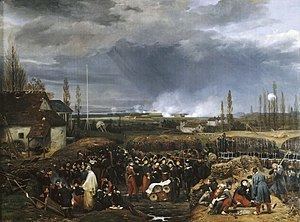370 dead 560 dead Result French victory | Dates 15 Nov 1832 – 23 Dec 1832 | |
 | ||
Combatants United Kingdom of the Netherlands, July Monarchy Similar Ten Days' Campaign, Belgian Revolution, Fall of Antwerp, Battle of Leuven, Battle of Hasselt | ||
The Siege of Antwerp took place after fighting in the Belgian Revolution ended. On 15 November 1832, the French Armée du Nord under Marshal Gérard began to lay the Dutch troops there under David Chassé under siege. The siege ended 23 December 1832. The French had agreed with the Belgian rebels that they would not participate in the battle.
Contents
Following the French army's first intervention in 1831, the Dutch withdrew from Belgium but left a garrison in the citadel at Antwerp, from which they bombarded the town. The Armée du Nord and its siege specialist François, Baron Haxo took 24 days to take this citadel and return it to Belgium. Leopold I of Belgium gave France several cannon of different calibres as thanks for this action and the French Chamber of Peers offered Gérard an épée d'honneur ("sword of honour"). A monument to the French dead in the siege was sculpted in 1897, but the town of Antwerp refused to take it and it is now in Tournai.
Siege of antwerp 1914
Background
When the Dutch withdrew from Belgium after the campaign called the Ten Days' Campaign, they left a garrison in the citadel of Antwerp, which resulted in a second operation of the Armée du Nord of Marshal Gérard, who returned with his army to Belgium November 15, 1832, when he laid siege to Antwerp.
The Dutch general Chassé, a former soldier of Napoleon, bombarded the city of Antwerp from the fort using heated shot, setting fire to hundreds of homes and causing many casualties among the civilian population. This caused the intervention of the Belgian volunteers who until then had been kept out of combat. Meanwhile, the Belgian army, gradually formed and re-equipped, went to defend the dikes of the Scheldt north of Antwerp, preventing the Dutch from damaging them.
Siege
For several decades, the siege tactics of the Vauban fortresses were limited to the method of the saps and parallels, usually causing the surrender of the besieged soon after the fortifications were pierced. The Armée du Nord conceived of the idea of using one of the first large mortars. Unlike guns and muskets that shoot in a straight line, mortars can fire a projectile through a curve that allows it to land directly on top of the fortress's defenders' heads.
Commemoration and legacy
Leopold I gave several guns of various calibers to France and Marshal Gerard received a sword of honor offered by the King and the Belgian government in gratitude. The French Monument, carved in 1897 to celebrate the memory of French soldiers who fell for the capture of Antwerp in 1832, is currently in Tournai following the refusal of the city of Antwerp to accept it.
In June 1837, to celebrate the marriage of the Duke of Orleans, the Champ de Mars in Paris served to represent the scene of the mock capture of the citadel of Anvers.
